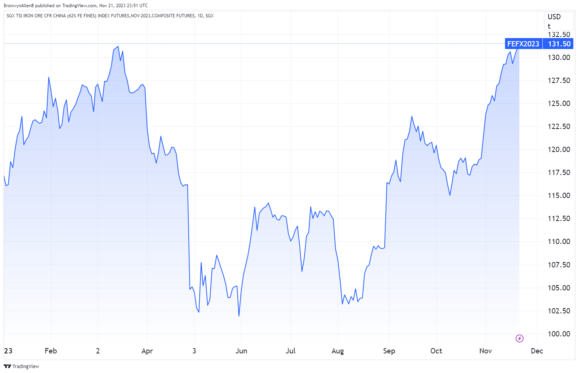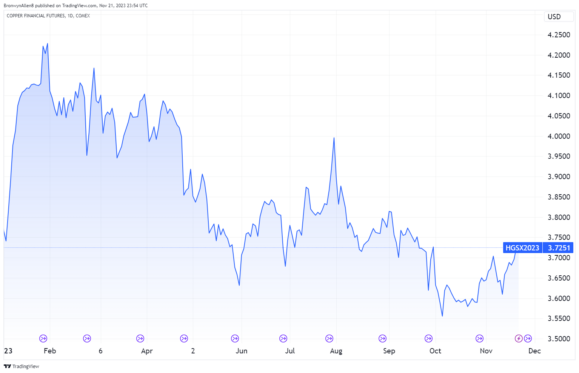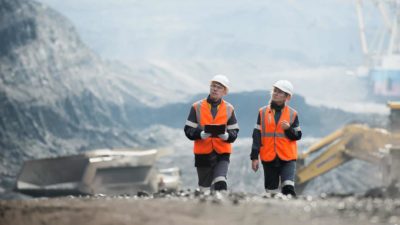The iron ore price will go to US$140 per tonne and the copper price will rise to US$8,600 per tonne, according to the upgraded three-month forecast of top broker Citi.
Citi previously predicted the iron ore price would lift to US$120 per tonne and the copper price would go to US$7,500 per tonne.
But now, the broker says fiscal support from the Chinese government to expand its economy and support the ailing property market will be "larger and more imminent than we previously expected".
Fiscal expansion in China to push the iron ore price higher
When China boosts its economic growth, that typically means more demand for Australian metals and minerals like iron ore and copper, thereby pushing up commodity prices.
China is the world's biggest iron ore consumer, importing 71% of the iron ore supply, according to Australian government data. Increased demand has a direct impact on the iron ore price.
Citi analysts said (courtesy The Australian):
We now expect in our base cases that China will likely increasingly push towards fiscal expansion to engineer investment-led growth, and this time with a focus on urban village redevelopment/affordable housing to support overall property market related activity in 2024.
This results in a significant increase in our confidence around stable consumption from this portion of the market instead of declines which are forecast for the commodity housing component.
Heading into 2024, our economists see the return of the pledged supplementary lending facility as a baseline to support the urban village redevelopment.
China's property new starts growth – commodity housing and urban village redevelopment – could potentially flip into positive territory from here if Beijing were to follow through.
What's happening with the iron ore price?

The iron ore price rose by 1.49% in overnight trading to US$136.50 per tonne. This is its highest price in more than eight months, as expectations of robust demand coincide with risks to supply.
According to analysis from Trading Economics:
Beijing stated it would accelerate the issuance of bonds after accommodating for an additional CNY 1 trillion in debt to target infrastructure and manufacturing projects.
The developments magnify previous signals from lenders, miners, and metallurgists that infrastructure expenditure in China is expected to offset the debt crisis for the residential construction sector, maintaining active purchasing activity for iron ore inputs.
The strengthening iron ore price has helped push various ASX 200 iron ore shares higher.
The Fortescue Metals Group Ltd (ASX: FMG) share price has risen by 23% in just one month, reaching two-year highs. Fortescue shares are currently $25.62 apiece, up 0.75% on Wednesday.
BHP Group Ltd (ASX: BHP) shares are up 1.05% to $47.91.
Rio Tinto Ltd (ASX: RIO) shares are up 0.68% to $128.23.
What's happening with the copper price?
The copper price rose 0.17% in overnight trading to $3.8065 per pound or US$8,390 per tonne. This is the highest price in more than two months due to expectations of higher demand amid lower inventories.
According to Trading Economics:
Inventories at the SHFE plunged by 45% from the corresponding week of the previous month on the week ending November 17th, triggering a fresh increase in the Yangshan copper premium to underscore firms' immediate need for the material.
In the meantime, evidence of slowing prices in the US strengthened bets that the Fed will refrain from hiking rates further, pressuring the dollar used to price copper and raising hopes of manufacturing-friendly financial conditions across economies with exposure to US credit markets.
Additionally, demand is expected to be sustained in China as Beijing pledged to target CNY 1 trillion in manufacturing and infrastructure development, lifting the outlook for copper.
On top of that, reports stated that the PBoC could inject CNY 1 trillion into the country's debt-ridden property developers.

A rising copper price is also supportive for BHP shares, particularly following the company's purchase of copper miner Oz Minerals earlier this year.
Rio Tinto has also expanded its copper mining business to capitalise on the decarbonisation trend and growing demand for copper, which is used in electric vehicles, solar energy systems, and wind turbines.






